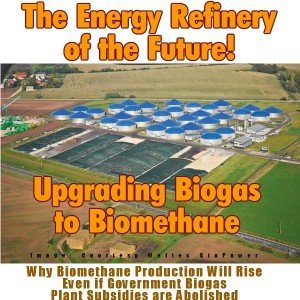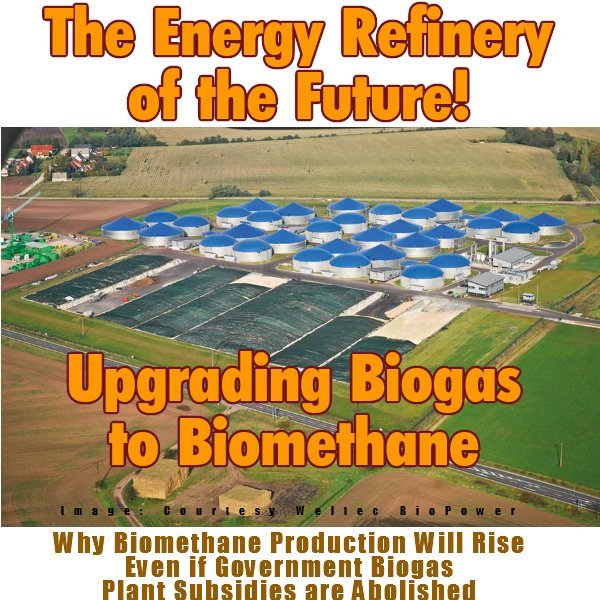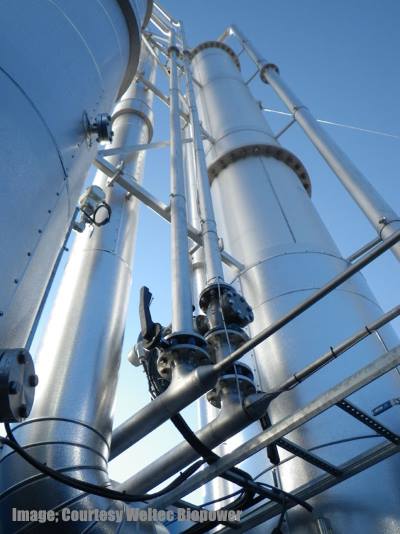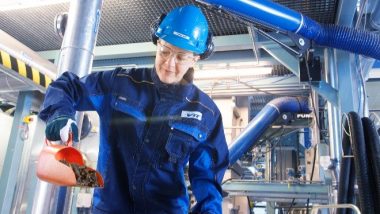
We still believe that Biomethane Output will rise in the UK and Europe, despite UK Government Biogas Plant Subsidy removal and degradation. Our original graphic (shown on the left here) which was made to accompany this article now looks over-optimistic for the time.
Nevertheless, there are so many reasons why this renewable fuel will be much sought-after and the market price will soon support its use without any subsidy. This will happen as climate change gains a stronger grip, and decarbonisation becomes a more urgent imperative.
Biomethane has unrivaled advantages for use as a low-emissions transport fuel, especially in the short term.
Biomethane Output Optimism in 2015
Back in 2015, when we first wrote about biomethane production, we were very optimistic that the level of activity would continue seen in that year would continue.
There had been a very rapid rise in biomethane production, when this article was first published, in October 2015. But, that year proved to be a peak year for growth in UK biomethane production facility output.
Anyone who was taking an interest in the anaerobic digestion industry and the renewable energy scene would have seen a rash of announcements of new AD Plants which were from the outset equipped with biogas upgrade equipment. There were also, no doubt, some existing AD facilities where biogas upgrading equipment was added to some traditional electrical power generation plants to allow them to move over biomethane production.
UK Government Biogas Plant Subsidy Reductions
2015 also proved to be the year when the new UK government, freed by the General Election of that year from policy restraint, began to substantially reduce the national green energy subsidies. From 2010 until 2015, the Conservative/Liberal Coalition had been in power. The coalition government which had been forced to maintain some green energy subsidies by the Liberal Party, was free to make any subsidy cuts it wished.
So it was that the abundance of activity in the UK biogas sector was killed-off by the progressive lowering of all government subsidies.
Some were are removed, at a stroke for new AD plants, such ROCs Scheme, and other such as the FiT were reduced before being closed. In the UK, now only the Renewable Heat Incentive (RHI) remains to help subsidize costs for new AD plant applicants, and in 2020 even that is due to stop.
But, the story is different in Europe. Read on and, please tell us what you think.
The original article as published in 2015 follows:
European Biomethane Use is Driven By National Renewables Obligations
In Europe it is easy to see why this is occurring, because whether or not transport fuel can be made at a price that is economically competitive with fossil fuels, renewable fuels must be used. The reason for this obligation derives from the Renewable Energy Directive RED 2009/28/EC which has been enacted throughout the EU states for the increased use of energy from renewable sources.
This directive dictates that 20% of the energy needs of each member state will have to be obtained from renewable sources, and within that target, 10% of the energy used in transport (transport fuels) has to be from renewable sources by 2020.
Biogas and in reality, its cleaned-up “pure” output, which is known as biomethane, will play a major role in achieving these targets. And, in order to achieve them there is a huge expansion needed in biomethane production if the target is going to be achieved by 2020.
To put it simply EU transport fleet operators will have to find their own sources of biomethane, or what is often called “green” gas, and the cost will be no excuse for not using it. So, don’t be surprised to be reading a lot about biomethane projects from now on.
US Biomethane Drivers
The position in the US, is that similar rises in biomethane production are occurring, but the driving forces are rather different. In the landfill sector the collection of landfill gas is rising due to new policies which encourage landfill gas extraction in order to reduce its carbon emission effects, and most importantly its impact on climate change. Landfill sites remote from HV electricity distribution lines must bottle their LFG as a necessity in order to find a buyer.
In the US, The number of anaerobic digestion plants is also rising fast, encouraged but not necessarily subsidized by government policy. The US is large and many anaerobic digestion plant sites are not close to power lines, nor are electricity companies obliged to accept renewable power in the way that they are in most EU countries. As a result, at many AD Plant sites there is no alternative but to upgrade the biogas and bottle the biomethane output for transport use.
Biomethane Output Gets Rising Investment
Industrial investors love market certainty of the sort that exists in the EU, so they are seeing rising investment and production increases in biomethane, and this will continue into the future drive by the stipulation that 10% of the energy needs in transport has got to come from renewable sources. Similarly, in the US there is a captive market for biomethane upgrade technology
Although many people will see the EU’s 10% “renewable” requirement as bureaucratic political imposition, it makes a lot of sense as a major plank in the EU’s decarbonisation policy. In addition, the adoption of upgraded biogas as vehicle fuel, in preference to using it for electricity generation, is seen by energy experts as one of the most efficient means of utilizing this form of renewable energy (biogas) to reduce carbon (greenhouse-gas-effect) emissions from the transportation industries.
 Sacrificial Loads Reducing as Well as Equipment Supplier Prices Dropping
Sacrificial Loads Reducing as Well as Equipment Supplier Prices Dropping
Until now, biomethane production was quite slow to be adopted. It added cost, and the substantial sacrificial load on the biogas plant’s total energy output, had a negative impact on cost as well. Biogas upgrading using the current technologies, until recently was energy-intensive. In fact, many reported that upgrading equipment consumed up to one third of the energy of the biogas produced. Thankfully, this picture is changing, and with the advent of more efficient low pressure membrane systems, with improved long-life membrane technology, and the use of better optimized Pressure Swing Adsorption (PSA) technology. This can also be used with an ionic liquid, usually in the form of a liquid CO2 absorption solvent, so that energy consumption in the upgrading process is now reducing rapidly.
Anticipated Further Technological Improvements
The upgrading process, which consists of separating the carbon dioxide and the lesser unwanted components from the biogas obtained from biogas plants or landfill gas extraction systems, will no doubt further improve, as the market grows and becomes more competitive. In fact, if the desired technological efficiency improves, the energy content of upgraded biogas will rise to mean that the renewable energy from biogas is both low cost, and also closely comparable to natural gas in its purity and constituents. That means that it will not only be used for transport engine fuels, but will also be sold for injection into natural gas distribution mains
Energy Which Can Come From Waste
The anaerobic digestion system which is used for the production of methane from organic feed materials, is uniquely capable of using waste materials as its energy source, which are available very cheaply or at near zero cost. It is a multi-stage process that utilizes a “community” of microbial organisms to be successful. The process has been developed in recent years and has already become much better understood through investment in research and development over the last 10 years. Research so far has mostly been by industry leaders to make it much more reliable in its output. However, now this has been achieved, interdisciplinary team of researchers, are focusing their skills on using specialized microbes to grow cooperative microbial communities that work more efficiently as methane producers, and from more waste materials than ever before.
Biomethane from Sources Other Than Anaerobic Digestion
As more and more renewable energy is being produced by intermittent energy sources, such as solar and wind, the production of biomethane as an energy storage medium, which is bottled and sold as “GNG” (Compressed Natural Gas), as transport fuel, using the energy to produce process gas “methane” is also an intriguing possibility.
Conclusion
So, the answer to the question we posed at the start is: No!
Although, for any government to remove subsidies so rapidly, as is happening now in the UK, is poor policy making and runs the risk of wasting much funding which has already gone into biogas projects, plus the livelihoods of many hardworking entrepreneurs.
You may also like to read:
Biogas Specialist Steps Up Plant Operations
WELTEC Group Acquires Two Biomethane Refineries
The WELTEC Group has acquired two biomethane refineries in Hesse and Saxony-Anhalt (Germany). One of the plants is located in Ebsdorfergrund, Hesse, and has been acquired within the framework of an asset deal. Nordmethan Produktion Ebsdorfergrund GmbH, an affiliate of the WELTEC Group, is now responsible for the operation as the new owner. For this purpose, all employees have been taken over.


 Sacrificial Loads Reducing as Well as Equipment Supplier Prices Dropping
Sacrificial Loads Reducing as Well as Equipment Supplier Prices Dropping


Biomethane will rise. It’s too important not to. Also, don’t forget Britain isn’t alone in needing to comply with its Climate Change targets. Or else how can they act clever and tell the rest of the world how bloody great they are?